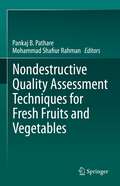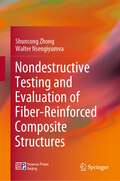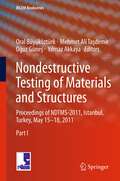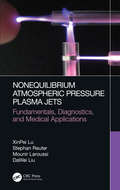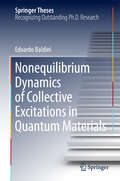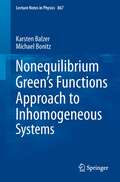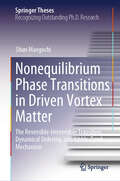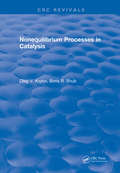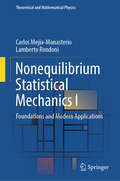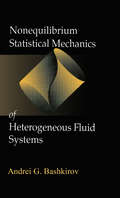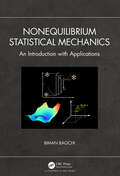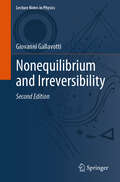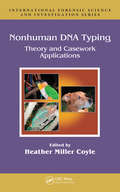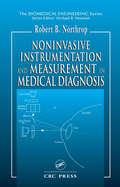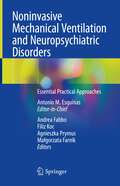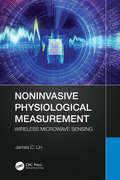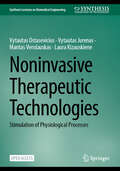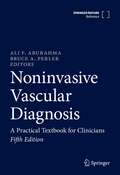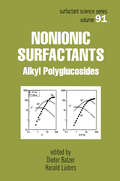- Table View
- List View
Nondestructive Quality Assessment Techniques for Fresh Fruits and Vegetables
by Mohammad Shafiur Rahman Pankaj B. PathareThis book describes the various techniques for nondestructive quality assessment of fruits and vegetables. It covers the methods, measurements, operation principles, procedures, data analysis, and applications for implementing these techniques.The book presents the details of nondestructive approaches focusing on the present-day trends and existing future opportunities in the fresh food supply chain. First, it overviews different nondestructive techniques in food quality detection. Then it presents nondestructive methods: monochrome computer vision, imaging techniques, biospeckle laser technique, Fourier Transform Infrared (FTIR) Spectroscopy, hyperspectral imaging, Raman spectroscopy, near infrared (NIR) spectroscopy, X-ray computed tomography, ultrasound, acoustic emission, chemometrics, electronic nose and tongue. Selected applications of each method are also introduced. As a result, readers gain a better understanding of how to use nondestructive methods and technologies to detect the quality of fresh fruits and vegetables.With a wide range of interesting topics, the book will benefit readers including postharvest & food scientists/technologists, industry personnel and researchers involved in fresh produce quality detection. The book can also serve as a readily accessible reference material for postgraduate students.
Nondestructive Testing and Evaluation of Fiber-Reinforced Composite Structures
by Shuncong Zhong Walter NsengiyumvaThis book presents a detailed description of the most common nondestructive testing(NDT) techniques used for the testing and evaluation fiber-reinforced composite structures, during manufacturing and/or in service stages. In order to facilitate the understanding and the utility of the different NDT techniques presented, the book first provides some information regarding the defects and material degradation mechanisms observed in fiber-reinforced composite structures as well as their general description and most probable causes. It is written based on the extensive scientific research and engineering backgrounds of the authors in the NDT and structural health monitoring (SHM) of structural systems from various areas including electrical, mechanical, materials, civil and biomedical engineering. Pursuing a rigorous approach, the book establishes a fundamental framework for the NDT of fiber-reinforced composite structures, while emphasizing on the importance of technique’s spatial resolution, integrated systems analysis and the significance of the influence stemming from the applicability of the NDT and the physical parameters of the test structures in the selection and utilization of adequate NDT techniques.The book is intended for students who are interested in the NDT of fiber-reinforced composite structures, researchers investigating the applicability of different NDT techniques to the inspections of structural systems, and NDT researchers and engineers working on the optimization of NDT systems for specific applications involving the use of fiber-reinforced composite structures.
Nondestructive Testing of Materials and Structures
by Mehmet Ali Taşdemir Oral Büyüköztürk Oğuz Güneş Yılmaz AkkayaCondition assessment and characterization of materials and structures by means of nondestructive testing (NDT) methods is a priority need around the world to meet the challenges associated with the durability, maintenance, rehabilitation, retrofitting, renewal and health monitoring of new and existing infrastructures including historic monuments. Numerous NDT methods that make use of certain components of the electromagnetic and acoustic spectrum are currently in use to this effect with various levels of success and there is an intensive worldwide research effort aimed at improving the existing methods and developing new ones. The knowledge and information compiled in this book captures the current state of the art in NDT methods and their application to civil and other engineering materials and structures. Critical reviews and advanced interdisciplinary discussions by world-renowned researchers point to the capabilities and limitations of the currently used NDT methods and shed light on current and future research directions to overcome the challenges in their development and practical use. In this respect, the contents of this book will equally benefit practicing engineers and researchers who take part in characterization, assessment and health monitoring of materials and structures.
Nonequilibrium Atmospheric Pressure Plasma Jets: Fundamentals, Diagnostics, and Medical Applications
by XinPei Lu Stephan Reuter Mounir Laroussi DaWei LiuNonequilibrium atmospheric pressure plasma jets (N-APPJs) generate plasma in open space rather than in a confined chamber and can be utilized for applications in medicine. This book provides a complete introduction to this fast-emerging field, from the fundamental physics, to experimental approaches, to plasma and reactive species diagnostics. It provides an overview of the development of a wide range of plasma jet devices and their fundamental mechanisms. The book concludes with a discussion of the exciting application of plasmas for cancer treatment. The book provides details on experimental methods including expert tips and caveats. covers novel devices driven by various power sources and the impact of operating conditions on concentrations and fluxes of the reactive species. discusses the latest advances including theory, modeling, and simulation approaches. gives an introduction, overview and details on state of the art diagnostics of small scale high gradient atmospheric pressure plasmas. covers the use of N-APPJs for cancer applications, including discussion of destruction of cancer cells, mechanisms of action, and selectivity studies. XinPei Lu is a Chair Professor in the School of Electrical and Electronic Engineering at Huazhong University of Science and Technology. Stephan Reuter is currently Visiting Professor at Université Paris-Saclay. In a recent Alexander von Humboldt research fellowship at Princeton University, he performed ultrafast laser spectroscopy on cold plasmas. Mounir Laroussi is Professor of Electrical and Computer Engineering and director of the Plasma Engineering and Medicine Institute at Old Dominion University. He is a Fellow of IEEE and recipient of an IEEE Merit Award. DaWei Liu is Professor in the School of Electrical and Electronic Engineering at Huazhong University of Science and Technology.
Nonequilibrium Dynamics of Collective Excitations in Quantum Materials (Springer Theses)
by Edoardo BaldiniThis book studies the dynamics of fundamental collective excitations in quantum materials, focusing on the use of state-of-the-art ultrafast broadband optical spectroscopy. Collective behaviour in solids lies at the origin of several cooperative phenomena that can lead to profound transformations, instabilities and phase transitions. Revealing the dynamics of collective excitations is a topic of pivotal importance in contemporary condensed matter physics, as it provides information on the strength and spatial distribution of interactions and correlation. The experimental framework explored in this book relies on setting a material out-of-equilibrium by an ultrashort laser pulse and monitoring the photo-induced changes in its optical properties over a broad spectral region in the visible or deep-ultraviolet. Collective excitations (e.g. plasmons, excitons, phonons…) emerge either in the frequency domain as spectral features across the probed range, or in the time domain as coherent modes triggered by the pump pulse. Mapping the temporal evolution of these collective excitations provides access to the hierarchy of low-energy phenomena occurring in the solid during its path towards thermodynamic equilibrium. This methodology is used to investigate a number of strongly interacting and correlated materials with an increasing degree of internal complexity beyond conventional band theory.
Nonequilibrium Green's Functions Approach to Inhomogeneous Systems
by Karsten Balzer Michael BonitzThis book offers a self-contained introduction to non-equilibrium quantum particle dynamics for inhomogeneous systems, including a survey of recent breakthroughs pioneered by the authors and others. The approach is based on real-time Green's functions.
Nonequilibrium Many-Body Theory of Quantum Systems
by Gianluca Stefanucci Robert Van LeeuwenThe Green's function method is one of the most powerful and versatile formalisms in physics, and its nonequilibrium version has proved invaluable in many research fields. This book provides a unique, self-contained introduction to nonequilibrium many-body theory. Starting with basic quantum mechanics, the authors introduce the equilibrium and nonequilibrium Green's function formalisms within a unified framework called the contour formalism. The physical content of the contour Green's functions and the diagrammatic expansions are explained with a focus on the time-dependent aspect. Every result is derived step-by-step, critically discussed and then applied to different physical systems, ranging from molecules and nanostructures to metals and insulators. With an abundance of illustrative examples, this accessible book is ideal for graduate students and researchers who are interested in excited state properties of matter and nonequilibrium physics.
Nonequilibrium Molecular Dynamics
by Billy D. Todd Peter J. DaivisWritten by two specialists with over twenty-five years of experience in the field, this valuable text presents a wide range of topics within the growing field of nonequilibrium molecular dynamics (NEMD). It introduces theories which are fundamental to the field - namely, nonequilibrium statistical mechanics and nonequilibrium thermodynamics - and provides state-of-the-art algorithms and advice for designing reliable NEMD code, as well as examining applications for both atomic and molecular fluids. It discusses homogenous and inhomogenous flows and pays considerable attention to highly confined fluids, such as nanofluidics. In addition to statistical mechanics and thermodynamics, the book covers the themes of temperature and thermodynamic fluxes and their computation, the theory and algorithms for homogenous shear and elongational flows, response theory and its applications, heat and mass transport algorithms, applications in molecular rheology, highly confined fluids (nanofluidics), the phenomenon of slip and how to compute it from basic microscopic principles, and generalized hydrodynamics.
Nonequilibrium Phase Transitions in Driven Vortex Matter: The Reversible-Irreversible Transition, Dynamical Ordering, and Kibble-Zurek Mechanism (Springer Theses)
by Shun MaegochiThis book presents experimental studies of nonequilibrium phase transitions induced by ac and dc forces in collectively interacting systems—a superconducting vortex system with random pinning. It first shows that a phase transition from reversible to irreversible flow occurs by increasing vortex density as well as amplitude of ac shear, which is indicative of the universality of the reversible-irreversible transition. Two distinct flow regimes are also found in the reversible phase. Next, the book presents new methods for dc driven experiments—transverse mode-locking and transverse current-voltage measurements—and provides convincing evidence of the second-order dynamical transition from disordered plastic to anisotropically ordered smectic flow. Lastly it reports on the first experimental demonstration of the Kibble-Zurek mechanism for the nonequilibrium phase transition.The experimental results indicate that both the reversible-irreversible transition and the dynamical ordering transition belong to the directed percolation universality class which is one of the fundamental classes of nonequilibrium phase transitions. Hence, the findings will be generalized to other nonequilibrium systems and stimulate research on nonequilibrium physics.
Nonequilibrium Processes in Catalysis
by Oleg V. KrylovNonequilibrium Processes in Catalysis presents modern ideas and experimental data (e.g., molecular beams, laser technique) on adsorption and catalysis, the mechanism of energy exchange in the processes of particles interaction with a surface, and the lifetimes of excited particles on a surface. Previously unpublished theoretical information regarding the principle of chemoenergetical stimulation accounting for the acceleration of one reaction at the expense of reactant excitation in another is provided, and new ideas about nonequilibrium surface diffusion are explored. Examples of the formation of nonequilibrium dissipative structures in catalysis are presented, including auto-oscillations, auto-waves, multiplicity of kinetic regimes, nonequilibrium phase transition, and decelerated electron exchange between solid and adsorbed species. The book also describes new experimental methods for studying nonequilibrium and quick processes in catalysis. Nonequilibrium Processes in Catalysis will benefit physicists involved with surface science, chemists involved with adsorption and catalysis, engineers, vacuum scientists, physical chemists, materials chemists, students, and others interested in these processes.
Nonequilibrium Statistical Mechanics I: Foundations and Modern Applications (Theoretical and Mathematical Physics)
by Lamberto Rondoni Carlos Mejía-MonasterioThis textbook offers a clear, unified introduction to nonequilibrium statistical mechanics. It combines the classical foundations of equilibrium and nonequilibrium thermodynamics with the field's latest advances. Key topics include Brownian motion, fluctuations theory, the Boltzmann equation, and probability measures in phase space. A common mathematical framework links linear-response theory, transport processes, large-deviation principles, and stochastic dynamics. A companion Volume II will extend the discussion to applications such as anomalous transport, living matter, molecular dynamics, and open quantum systems. The book is written for researchers in applied mathematics, theoretical physics, biophysics, and theoretical chemistry who study nonequilibrium phenomena. It is equally suited to graduate students seeking an accessible path to advanced topics in thermodynamics, transport theory, fluctuation dynamics, and dissipation. It also serves as a reference for graduate courses on statistical mechanics, stochastic systems, and quantum thermodynamics.
Nonequilibrium Statistical Mechanics of Heterogeneous Fluid Systems
by Andrei G. BashkirovThere is a wide variety of heterogeneous fluid systems that possess interphase surfaces. This monograph is devoted to pioneering studies in nonequilibrium statistical mechanics of such systems. Starting from the Liouville equation, the equations of surface hydrodynamics are derived with allowance for discontinuities of thermodynamic parameters of interphase boundaries. Brownian motion of a large solid particle in a fluid and nucleation are treated as results of fluctuations of flows across particle surfaces. With the use of the Gibbs method, a shock wave in a gas is considered as a sort of an interphase surface, and the surface tension of a shock front is introduced for the first time.
Nonequilibrium Statistical Mechanics: An Introduction with Applications
by Biman BagchiNonequilibrium statistical mechanics (NESM), practically synonymous with time-dependent statistical mechanics (TDSM), is a beautiful and profound subject, vast in scope, diverse in applications, and indispensable in understanding the changing natural phenomena we encounter in the physical, chemical and biological world. Although time dependent phenomena have been studied from antiquity, the modern subject, the nonequilibrium statistical mechanics, has its genesis in Boltzmann’s 1872 classic paper that aimed at extending Maxwell’s kinetic theory of gases by including intermolecular interactions. Subsequent development of the subject drew upon the seminal work of Einstein and Langevin on Brownian motion, Rayleigh and Stokes on hydrodynamics, and on the works of Onsager, Prigogine, Kramers, Kubo, Mori, and Zwanzig. One major goal of this book is to develop and present NESM in an organized fashion so that students can appreciate and understand the flow of the subject from postulates to practical uses. This book takes the students on a journey from fundamentals to applications, mostly using simple mathematics, and fundamental concepts. With the advent of computers and computational packages and techniques, a deep intuitive understanding can allow the students to tackle fairly complex problems, like proteins in lipid membranes or solvation of ions in electrolytes used in batteries. The subject is still evolving rapidly, with forays into complex biological events, and materials science. Nonequilibrium Statistical Mechanics: An Introduction with Applications is, thus, an introductory text that aims to provide students with a background and skill essential to study and understand time-dependent (relaxation) phenomena. It will allow students to calculate transport properties like diffusion and conductivity. The book also teaches the methods to calculate reaction rate on a multi-dimensional energy surface, in another such application. For a beginner in the field, especially for one with an aim to study chemistry and biology, and also physics, one major difficulty faced is a lack of organization of the available study material. Since NESM is a vast subject with many different theoretical tools, the above poses a problem. This book lays the foundations towards understanding time- dependent phenomena in a simple and systematic fashion. It is accessible to students and researchers who have basic training in physics and mathematics. The book can be used to teach advanced undergraduates. Some involved topics, like the projection operator technique and mode coupling theory, are more suitable for Ph.D. level.
Nonequilibrium Statistical Physics: A Modern Perspective
by Roberto Livi Paolo PolitiStatistical mechanics has been proven to be successful at describing physical systems at thermodynamic equilibrium. Since most natural phenomena occur in nonequilibrium conditions, the present challenge is to find suitable physical approaches for such conditions: this book provides a pedagogical pathway that explores various perspectives. The use of clear language, and explanatory figures and diagrams to describe models, simulations and experimental findings makes the book a valuable resource for undergraduate and graduate students, and also for lecturers organizing teaching at varying levels of experience in the field. Written in three parts, it covers basic and traditional concepts of nonequilibrium physics, modern aspects concerning nonequilibrium phase transitions, and application-orientated topics from a modern perspective. A broad range of topics is covered, including Langevin equations, Levy processes, directed percolation, kinetic roughening and pattern formation.
Nonequilibrium and Irreversibility (Lecture Notes in Physics #1040)
by Giovanni GallavottiThis 2nd edition of the book focuses on the properties of stationary states in chaotic systems of particles or fluids, setting aside the theory of how these states are achieved. The second edition has been thoroughly revised and includes numerous corrections. It incorporates recent findings, with particular emphasis on the equivalence between irreversible and reversible equations. The ongoing debate over reversibility and irreversible behavior is frequently discussed. The book seeks to unify the study of stationary nonequilibrium states with that of equilibrium states, using the paradigm offered by the simplest chaotic systems, specifically Anosov systems. The book begins by exploring the time-invariant distributions relevant to physics. A distinctive feature of this work is its historical approach. To clarify foundational issues, the author analyzes the works of pioneering figures like Boltzmann, Clausius, and Maxwell, including translated excerpts of key historical documents. Additionally, the author establishes a close connection between the treatment of irreversible phenomena in statistical mechanics and the theory of chaotic systems, particularly at and beyond the onset of turbulence, as developed by Sinai, Ruelle, and Bowen (SRB) and others. Arguments are presented to strongly support the perspective that stationary states, whether in equilibrium or not, can be described in a unified framework. The book offers extensive coverage of contemporary research, presented in sufficient detail to give advanced students a sense of the ongoing research directions in this dynamic field. Proofs of theorems are generally limited to heuristic outlines, favoring the presentation of concepts and providing references for further study, thereby avoiding an overload of technical detail in the main text.
Nonhuman DNA Typing: Theory and Casework Applications (International Forensic Science and Investigation)
by Heather Miller CoyleThe association of a suspect with the victim or crime scene through DNA evidence is one of the most powerful statements of complicity in a crime imaginable. No category of evidence has ever had the complete capacity to convict or exonerate an accused so absolutely in the eyes of the public. With the discriminatory powers of DNA and the variety of D
Nonhuman Humanitarians: Animal Interventions in Global Politics
by Benjamin MeichesExamining the appearance of nonhuman animals laboring alongside humans in humanitarian operations Both critical and mainstream scholarly work on humanitarianism have largely been framed from anthropocentric perspectives highlighting humanity as the rationale for providing care to others. In Nonhuman Humanitarians, Benjamin Meiches explores the role of animals laboring alongside humans in humanitarian operations, generating new ethical possibilities of care in humanitarian practice.Nonhuman Humanitarians examines how these animals not only improve specific practices of humanitarian aid but have started to transform the basic tenets of humanitarianism. Analyzing case studies of mine-clearance dogs, milk-producing cows and goats, and disease-identifying rats, Nonhuman Humanitarians ultimately argues that nonhuman animal contributions problematize foundational assumptions about the emotional and rational capacities of humanitarian actors as well as the ethical focus on human suffering that defines humanitarianism.Meiches reveals that by integrating nonhuman animals into humanitarian practice, several humanitarian organizations have effectively demonstrated that care, compassion, and creativity are creaturely rather than human and that responses to suffering and injustice do not—and cannot—stop at the boundaries of the human.
Nonhuman Primate Models For Human Diseases
by W. Richard DukelowWhile research has enabled us to better understand the nonhuman primates, they have repaid that by repaid that by providing medical scientists with important tools for the study of human biomedical problems. This book is about those research tools. The book was designed by identifying areas of human medical research that are under intensive research study today. Authors were then selected based on their expertise at using nonhuman primates as models for the human condition. Each was asked to use as comparative an approach as models for the human condition. Each was asked to use a comparative an approach as possible, to provide the reader with knowledge relating to the usefulness of various nonhuman primate species to each specific research area.
Noninvasive Instrumentation and Measurement in Medical Diagnosis
by Robert B. NorthropNoninvasive medical diagnosis (NIMD) is as old as medical practice itself. From the earliest healers' observations of odors, skin color, and breath sounds to today's wealth of technologies, the basics remain the same and keep the role of NIMD essential to effective medical care. Noninvasive Instrumentation and Measurement in Medical Diagnos
Noninvasive Mechanical Ventilation and Neuropsychiatric Disorders: Essential Practical Approaches
by Antonio M. Esquinas Andrea Fabbo Filiz Koc Agnieszka Prymus Małgorzata FarnikIn different sections of this book the relationships between the patterns of psychological response in acute and chronic respiratory failure, as well as the epidemiology of neuropsychiatric disorders in ventilator management, are collected and analyzed. Main concepts such as “vulnerability to stress”, critical illness-psychological stress and susceptibility that may develop during NIV support, as well as the diagnosis of neuropsychiatric disorders in respiratory failure are also summarized. A section is devoted to the most frequent indications of NIV, also including a special use of NIV in pandemic and high-risk infections, as well as in several other conditions such as acute and chronic respiratory failures and neurological disorders. A summary of practical approaches for treatment and prevention in neurologic and psychiatric disorders during noninvasive mechanical ventilation, as well as the perspective in terms of outcomes, quality-of-life, palliative care is also given.The book is intended for all those healthcare professionals treating patients suffering from neurological or psychiatric disorders and who develop acute or chronic respiratory failure. Neurologists, psychiatrists, pulmonary critical care professionals, geriatricians, internists and psychologists will find in the book a valuable guide for their everyday clinical practice.
Noninvasive Molecular Markers in Gynecologic Cancers
by Debmalya Barh Mehmet GunduzEarly detection is critical for any given cancer. With the advent of the latest omics technologies, molecular markers in combination with conventional diagnostic and screening methods are emerging as next-generation early diagnostic and prognostic strategies that can allow early-stage diagnosis, resulting in more effective treatment and patient car
Noninvasive Physiological Measurement: Wireless Microwave Sensing
by James C. LinThis book explains the principles and techniques of microwave physiological sensing and introduces fundamental results of the noninvasive sensing of physiological signatures, vital signs, as well as life detection. Specifically, noninvasive microwave techniques for contact, contactless, and remote sensing of circulatory and respiratory movements and physiological volume changes are discussed.Noninvasive Physiological Measurement: Wireless Microwave Sensing, is written by a pioneering researcher in microwave noninvasive physiological sensing and leading global expert in microwaves in biology and medicine. The book reviews current advances in noninvasive cardiopulmonary sensing technology and measurement. It includes measurements of the vital signs and physiological signatures from laboratory and clinical testing. The book discusses the applicable domains and scenarios in which there is an interaction of radio frequency (RF) and microwaves with biological matter in gas, fluid, or solid form, both from inside and outside of the human or animal body. The book also provides examples for healthcare monitoring and diagnostic applications through wearables, devices, or remote contactless sensors for physiological signals and signature, vital signs, and body motion sensing. This book is an essential guide to understanding the human body’s interaction with microwaves and noninvasive physiological sensing and monitoring.This book is intended for researchers and professionals in biomedical, electrical, and computer engineering with an interest in antenna, sensors, microwaves, signal processing, and medical applications. It will also be of interest to healthcare professionals, technologists, and practitioners interested in noninvasive physiological sensing and patient monitoring.
Noninvasive Therapeutic Technologies: Stimulation of Physiological Processes (Synthesis Lectures on Biomedical Engineering)
by Vytautas Ostasevicius Vytautas Jurenas Mantas Venslauskas Laura KizauskieneThis open access book unveils groundbreaking advancements in non-invasive therapeutic technologies, focusing on the integration of digital twins and artificial intelligence to enhance circulatory health. At the heart of this book is the exploration of innovative solutions that promise to revolutionize medical practices and patient care. The chapters delve into critical topics such as ultrasonic and vibrational blood flow activation, acoustic activation of human circulatory parameters, and acoustofluidic separation of bioparticles. Readers will discover how low-frequency ultrasound can safely dissociate erythrocytes from aggregates, reduce blood pressure and improve blood gas metabolism within minutes, and manage pulmonary hypertension without medication. The book also highlights the development of smart devices like the "Vilim ball" for tremor therapy and other patented technologies aimed at improving blood flow in diabetic patients and those with mobility impairments. This essential volume is a must-read for researchers, clinicians, and practitioners in the fields of biomedical engineering, mechatronics, and healthcare technology. It offers invaluable insights into cutting-edge therapeutic strategies that are set to transform both clinical settings and home care environments.
Noninvasive Vascular Diagnosis: A Practical Textbook for Clinicians
by Ali F. AbuRahma Bruce A. PerlerThis revised and updated edition reflects the increasing popularity of noninvasive techniques in the management of vascular disease. It represents the definitive text written on the subject and has been honed over the past editions to represent the enormous number of changes to the use of imaging to diagnose the multitude of conditions being seen in the clinic and surgical suite. Noninvasive Vascular Diagnosis comprehensively covers all aspects of noninvasive evaluation of the circulatory system, including the extremities, cerebrovascular, and abdomen. In this updated edition, it is well supported by exceptional illustrative material, making it invaluable to all those who work in vascular laboratories as well as internists, cardiologists, radiologists, vascular surgeons, vascular medicine specialists, vascular laboratory directors and staff, general surgeons involved in vascular surgery and the vascular surgery community in general.
Nonionic Surfactants: Alkyl Polyglucosides (Surfactant Science #91)
by Dieter Balzer Harald LüdersThis volume provides a comprehensive overview for recognizing and producing the characteristics of successful special surfactant agents. It highlights one of the most versatile and effective surface-active surfactant agents, detailing the synthesis and production, chemical properties and behaviours, and application for alkyl polyglucosides.
